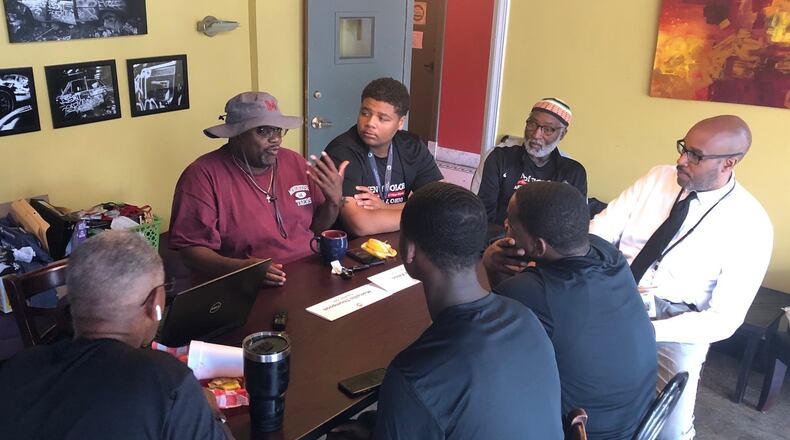RELATED: Summit aims to improve black male education
Efforts to help black students have been growing in recent years — from visible programs like first day of school cheerleading of students and last week’s annual youth summit, to behind-the-scenes mentoring efforts and classes on male responsibility and “rites of passage” to help boys understand themselves as they become men.
John Rogers, coordinator for Dayton Public Schools’ Office for Males of Color, said they plan to make significantly more mentoring opportunities available at after-school times that work better for working adults.
“Watch the city change the minute we pull this off,” Rogers said. “(Mims) has access to so many organizations — fraternities, churches, and they’re all in. We just have to give them the availability, the structure. This mentoring piece is going to lift the whole city.”
Longtime community activist Marlon Shackelford said there have been some mentoring successes before, pointing to a time when Dayton’s Boys Prep school had 61 mentors for 61 boys in a program. But he said black male culture doesn’t always do that well, and he put out a challenge to black men to get steadily involved.
RELATED: Schools working to end racial bias in suspensions
“We see black boys are dying,” Shackelford said. “How is it not possible to get one hour a week just coming to that school?”
Chaz Amos, a thriving senior at Thurgood Marshall High School, said he’s benefited from strong mentoring work first-hand, and he’s now starting his own mentoring program for younger students.
“When I was in fifth grade, I was an awful student. I was still getting suspended, getting into fights,” Amos said. “But when you see there’s someone out here who actually wants to take time to help you and show you, it makes you think differently.”
Mims has served a bevy of roles in education, from teacher and coach, to teachers union president, Dayton school board president and state school board member.
He regularly cites the importance of “the three A’s” — attendance, attitude and achievement. But he said another key to improving black male student outcomes is creating a wider variety of options in Dayton schools outside the core curriculum — things like music and art and sports outlets from a young age.
RELATED: Mentors aim to get young students on right path
Amos agreed, saying he knows students who were on the verge of dropping out but stuck with school because there was a class or activity such as band that they valued.
DPS has recently added more music classes, and Mims said a wider range of activities would give students more opportunities to experience success in one fashion or another. Mims said experiencing success is crucial to building confidence, and he said that confidence can become contagious.
A rise in black male performance could have a broad impact in the schools, but also the city.
“Those who used to be a drain on the budgets in terms of policing and recidivism can now get that positive energy going in the right direction, with more self-discipline, fewer incidents on things like domestic violence, less black-on-black crime,” Mims said.
Rogers’ DPS Males of Color Office is trying to reduce absenteeism and expulsions and increase graduation rates and the number of students taking advanced classes.
He said the community could change some ways it treats black male students, pointing to the example of Amos, who had clear potential, but needed intervention when he behaved badly in fifth grade.
RELATED: Education group struggles to close racial gaps
“You don’t beat that (potential) out of him and say he’s a bad kid,” Rogers said. “We actually need to keep up with him and provide more challenges.”
Shackelford repeatedly said adults have to challenge teens and give them opportunities to grow, but he also said efforts have to start much earlier for programs like Males of Color to work their best.
“You kids have obstacles in front of you. We need to be teaching that you have to go over some, under some, around some, and some you’ve got to go right through,” he said. “If you’re not teaching a kid that in the first grade, by fourth grade, he’s going to be saying, just throw me a basketball or a football, because he’s going to give up, saying, I don’t know how to deal with the obstacle.”
Dunbar senior Marcellis Thompson said the two Men of Color programs have molded him into a role model, and like Amos, he is trying to help younger students. But he said many teens need to put in the practical hard work.
“I believe most of the kids at Dunbar hear about college, but they don’t do the first steps to success, like grades and attendance … They only (visualize) what’s going to happen after high school and making money, but they don’t do the first steps to get there.”
Dayton schools’ Males of Color facilitator Joshua Nalls said it’s a matter of listening to students and hearing what the obstacles are that stand in their way, so adults can help them, build them up, and in turn create the next set of young leaders.
“Real leaders don’t plant trees and expect to just sit in the shade,” Nalls said. “You have to leave something behind that lasts longer than you. You have to want the next generation to be better than you.”
About the Author

